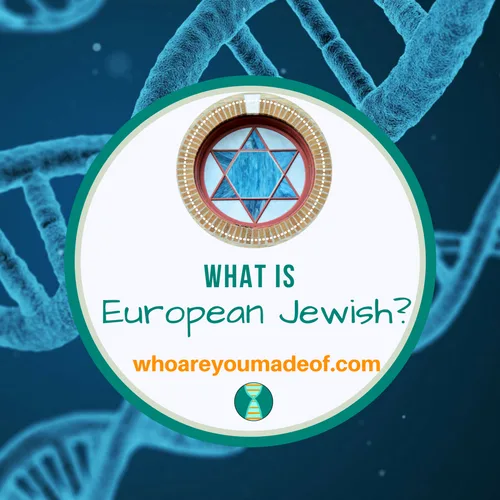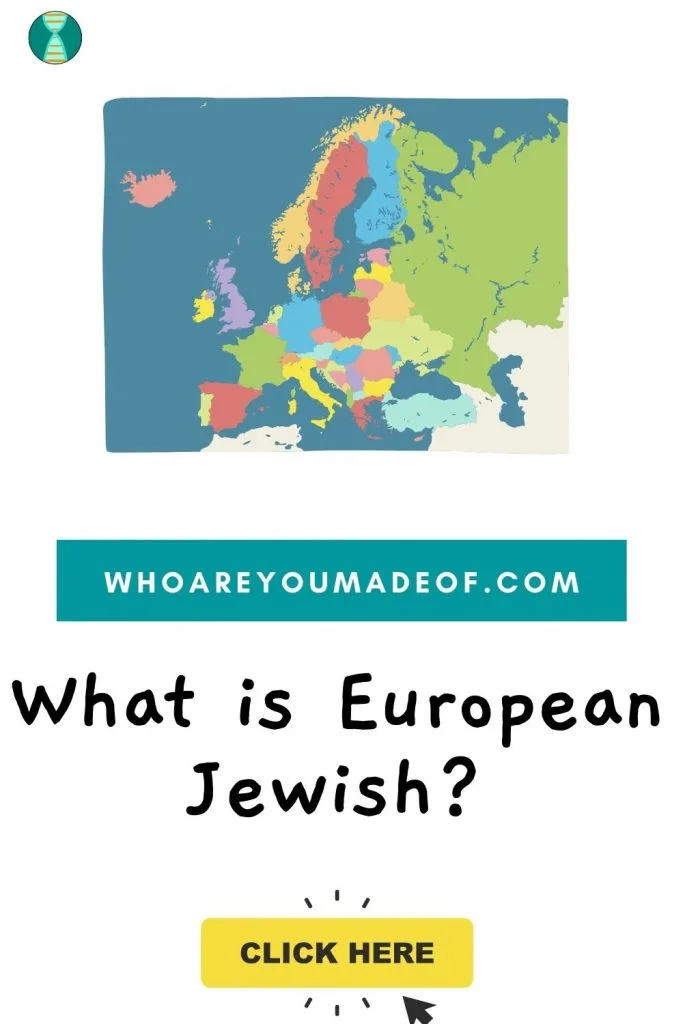Do you want to learn the meaning of European Jewish? In this post, learn what this term means, a bit about the history of the European Jewish people, and the answer to other common questions.
I first began wondering about the meaning of European Jewish when I first saw my Ancestry DNA results and saw that I had European Jewish DNA. I had no idea what to think.
To be honest, I didn’t know much about the Jewish religion, or Jewish people, and I knew even less about how I might have inherited Jewish DNA.
I had so many questions!

I spent a few years doing research, however, and in this post, I’ll share with you what I learned about the European Jewish people. This helped me learn more about my family and my Jewish ancestry.
Cool fact: If you have European Jewish DNA, then you should know that you are in excellent company. Albert Einstein, one of the most remarkable scientists in history, was a European Jew.
Is European Jewish the same as Ashkenazi?
Yes, these terms are often used interchangeably. If you have ever heard of Ashkenazi Jewish, then you should know that Asheknazi Jewish the same as European Jewish.
However, it is important to understand that the region in Europe where most European Jewish people have historically lived covers a large geographic area that includes a variety of cultures within the Jewish communities.
Ashkenazi, a Hebrew word that is used to refer to Germany, is used to describe the descendants of Jews who migrated from the Middle East through Europe.
The original European Jews, or Ashkenazi Jews, settled in France, Germany, and parts of Eastern Europe.
There is one other group of Jews that have historically lived Europe. They are referred to as Sephardic Jews and primarily settled on the Iberian Peninsula.
What is the difference between European Jewish and other Jewish groups?
There are three major “types”, or sub-groups of Jews: Ashkenazic, Sephardic (Hebrew for the region of Spain), and Mizrachim (Hebrew for “Eastern”). There are many other smaller groups of Jews around the world, but these are the three which will most relevant to the readers of this website.
Each of these Jewish groups will have slightly different – sometimes very different – cultural, linguistic, and religious traditions, but the most important fundamentals of their beliefs will be similar.
The major cultural and linguistic differences between the different Jewish communities are a result of geographic distance and the local cultures where Jewish people live. For example, some of the classic customs that come to mind when we think of Jewish traditions are foods that are eaten during special religious occasions, such as matzo balls, latkes, borscht, and blintzes.
These foods are examples of foods that became part of Ashkenazi Jewish cuisine through their connection to the countries where the Eastern European Jews made their home.
As an aside, I always think in terms of food, so I always seem to use food examples when I talk about cultural influences. Some people tend to view food as trivial and unimportant, but I find that food is a good way to explore and relate to the world.
In this post, when I mention food as part of a religious tradition, I don’t mean to offend or make it seem like I am taking the traditions lightly.
Of course, European Jews tend to speak the local languages where they live, like German, Polish, and Russian. Sometimes they speak Yiddish, which is an Ashkenazi Jewish language based on High German, Hebrew, Aramaic, and some Slavic and Romance languages.
Yiddish is also spoken many Jewish communities in the United States, with as many as 200,000 people speaking Yiddish at home.
It should be noted that the use of Yiddish declined dramatically after the Holocaust, since about 85% of the Jews who were killed in the Holocaust were Yiddish speakers. This, combined with Jews fleeing Eastern Europe and antisemitism in many of the countries where they settled, led to a continual decrease in its use.
There may be as many as 1.5 million Yiddish speakers in Europe now, which is a small number compared to the estimated 13 million Yiddish speakers before the Holocaust.
How can Jewish be an ethnicity and a religion?
If you can practice Judaism, and be Jewish, even if you weren’t born into the religion, how can some people be Jewish without being, well, Jewish? And why is Jewish referred to as an ethnicity when it is a religion?
The answer is that Jewish is both an ethnicity and a religion – Jews are an ethnoreligious group.
People who are ethnically Jewish are descended from people who migrated from the Middle East and settled down in parts of Northern Africa, the Iberian Peninsula, Germany, and Eastern Europe. However, it is possible to convert to Judaism, which is how some people might identify as having the Jewish religion, yet not the Jewish ethnicity.
Jewish communities were genetically isolated, generally speaking, from their surrounding communities, because of discrimination and religious and cultural practices. Some studies suggest that the majority of people with European Jewish ancestry are descended from four women who lived in Europe about a thousand years ago.
This meant that Jewish people often had children with only Jewish people, and their children married other Jewish people, and their descendants still show exceptionally strong genetic connections with other Jewish communities in the Middle East, even after the passing of many centuries.
Does having Jewish Peoples of Europe on my DNA results mean that I have a Jewish ancestor?
If you found Jewish Peoples of Europe in your DNA results, you might be wondering if this means that you have a Jewish ancestor. The higher percentage of European Jewish that you get on your results, the more likely it is that you actually do have Jewish ancestry.
The only way to know for sure if you are descended from a European Jewish family is to start building a family tree and research it carefully, generation by generation.
As I mentioned at the beginning of this post, I didn’t know that I had any Jewish ancestors when I first became interested in family tree research. When I got my DNA results back and saw that I had inherited Ashkenazi Jewish DNA from a line of my family tree, it inspired me to look a little harder at the lines of my family tree where there very well could have been Ashkenazi Jewish.
My mom is more than 60% Eastern European (per: Ancestry DNA) from Poland and Slovakia, so it seemed an easy thought that maybe my Jewish came from her.
While it could be true that my mother did have Jewish ancestors, she only inherited a small amount of Jewish DNA, and I have more than she does. I looked to my dad’s side of the family and I found that my great-great-great grandmother’s surname was Behrendt.
She was born in Alsace and Lorraine in 1852, which was Germany and is now France.
As it turns out, Jewish people have been living in the area for many centuries. I was able to find her birth record, and while she may have been Jewish by ethnicity, she was baptized in the Christian faith as an infant.
I’m hoping to learn more about her parents soon.
The reason that I wanted to mention this short story to you was because there was no way for me to know for sure who my Jewish ancestor might have been without really getting up close and personal with my family tree.
I have to learn as many details as possible about each of my ancestors in order to find out where my Jewish ancestor may have come into my direct line. While I haven’t found direct evidence yet, I know that if I keep searching, I might get lucky.
How can I find out if I have Jewish DNA?
Modern technology has allowed us to take a simple DNA test that can tell us where many of our more recent ancestors may have lived. While it is not a substitute for genealogy research, it can be a useful tool in directing us in learning about our ancestry.
There are a few different DNA testing companies that offer good quality results.
I’m a huge fan of DNA testing, and encourage everyone to do it – with one caveat. You always have to be prepared for whatever you learn. DNA testing can sometimes information that is surprising to us.
If you think you would like to do a DNA test to learn about possible Jewish ancestry, I recommend that you read my post about which test is best for Jewish ancestry, since I go into more detail about the topic.
Conclusion
I hope that this post helped answer some of the questions that you may have had when you first saw your Jewish Peoples of Europe ancestry on your DNA results. I’m sure that your questions were similar to those that I was asking, which is why I decided to write this post.
If you have any questions, comments, or concerns, I would love to continue the discussion in the comments.
Thanks for stopping by!



amare
Tuesday 7th of November 2023
my mom is portorican
Deb
Saturday 12th of February 2022
Thank you, an interesting read after finding out I have sone European Jewish DNA. My Dad is keen to find out if it is from his side so he has ordered a DNA testing kit. I am looking forward to deepening my result and hopeful to discover more.
Lonny Baskin
Monday 15th of November 2021
The terms Sephardi and Mizrahi mean the same thing. They are the descendents of Jews who were expelled from Spain in the Inquisition. I understand that you probably mean that Mizrahim are the Jews from Arab countries but in Israel, both mean the same thing. There are other types of Jews, such as the Black Jews of Africa, mostly meaning the Ethiopian Jews but there are other Jewish communities in Africa such as in Uganda. There are also the Cochin Jews of India and the ‘Oriental’ Jews who came to Israel as part of the Russian aliya of the 90’s. They look Chinese and are Jews. In short, we are a vast and diverse people who spread all over through the millennia and can no longer be described as just Ashkenazi or Sephardi.
Jennifer Day
Thursday 23rd of September 2021
Thank you for explaining European Jewish. My mom and son both have small traces. I don’t have any and was curious as what it could be. Time to research more of my French line!